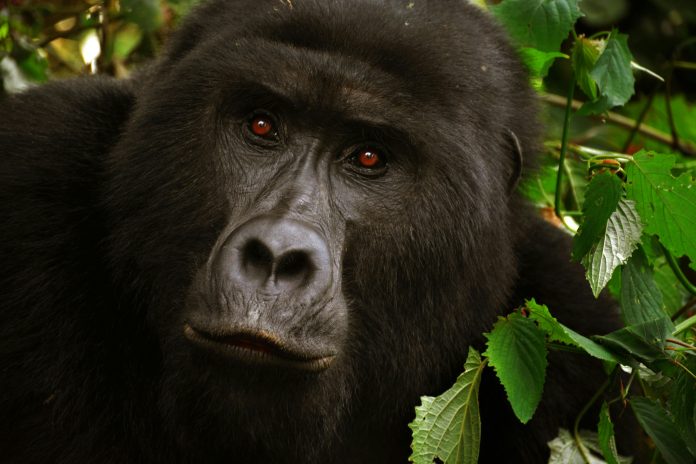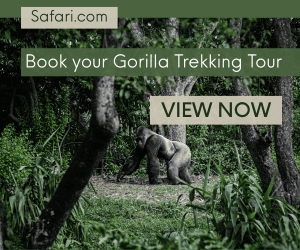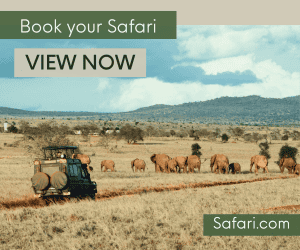Gorilla trekking is Africa’s most cherished, yet most expensive, wildlife experience.
In Uganda, the saying goes: “Gorillas in the mist; mzungus (foreigners) in the mud.”
People worldwide travel to the heart of Africa to trek gorillas through the dense forests of Uganda, DR Congo, and Rwanda, inspired by the conservation efforts of Dian Fossey and others to preserve this wonderful species for future generations.
As an experienced travel writer, I rate my gorilla trek in Uganda’s Bwindi Impenetrable Forest as the best tourism experience and wildlife encounter of my life.
Sure, it was expensive, but that hour with the gorillas was a time I will never forget. When you look into the eyes of a gorilla, some of life’s most profound questions are answered. After all, there’s no doubt that we’re descended from these great apes, who are so strikingly like us.
But I’m getting ahead of myself.
Before embarking on gorilla trekking in Uganda, I did lots of research to ensure that my trip would be as incredible (and budget-friendly) as possible.
So, I want to share my research with you in this article, my ultimate guide to gorilla trekking in Africa, with my first-hand experiences of this magical encounter with our close relatives.
Introduction to Gorilla Trekking
African gorilla trekking is a wildlife adventure unlike any other in the world. Park rangers invite you to trek through dense forests in Uganda, Rwanda, and the DR Congo to locate and observe endangered mountain gorillas.
Depending on the location of the family on the day of your gorilla trekking tour, you might hike for ten minutes or ten hours to locate them. Then, you get to spend one hour in their company, observing their every move as they go about their daily lives in their natural habitat.
This is possible because some mountain gorilla groups are habituated. In other words, they have been trained to be comfortable with human presence through years (up to five years) of hard work by rangers and trained wildlife experts.
Don’t mistake habituation for tameness. Habituated gorillas are wild and should never be mistaken for friendly, domesticated animals. You cannot get closer than seven metres to them during your gorilla trekking tour. This is for your safety and that of the gorillas. More on this later.
I encourage you to read up on the habituation process within Bwindi Impenetrable Forest to learn more about how gorillas are protected and prepared for human contact.
Top Gorilla Trekking Destinations in Africa
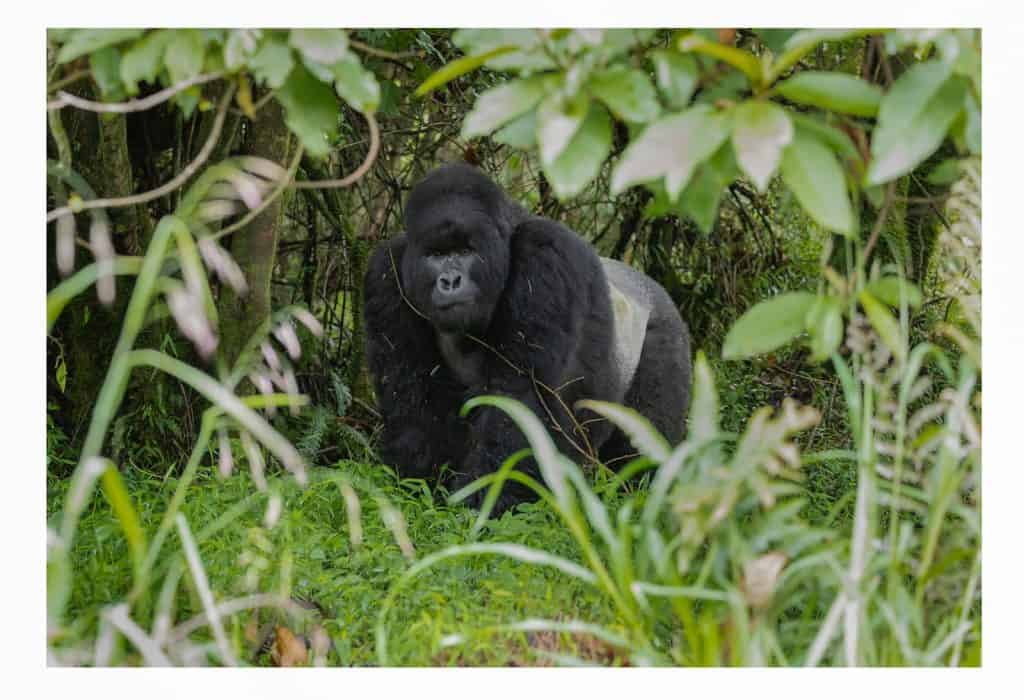
If you’re searching for gorilla trekking tours this year, you can only do this activity in three countries: Uganda, Rwanda, and the Democratic Republic of Congo.
At the time of writing, the eastern region of Congo is unsafe for travel due to an ongoing conflict that has worsened recently. Therefore, I recommend Uganda and Rwanda as your best options. However, I will still cover the basics of DR Congo gorilla trekking in case the security situation improves before your trip there.
Uganda
| 💲Gorilla Trekking Permit Cost | $800 |
| 📍Options for Gorilla Trekking | Bwindi Impenetrable Forest & Mgahinga Gorilla National Park |
| ☀️Best Time to Visit | June, July, August, September, December |
I believe Uganda is the best country for gorilla trekking in Africa. This is primarily because a trekking permit in Uganda is almost half the price of the same permit in Rwanda, costing $800 at the time of writing.
You can also choose to trek in two national parks in Uganda: Bwindi Impenetrable Forest & Mgahinga, both in the extreme south-west of the country.
Also, Uganda is safe, secure, and well served by airstrips, which makes up-country travel to the gorilla locations easy, if you have the funds to pay for it!
I chose to trek in Bwindi because I wanted to start at Buhoma, where I was staying. I trekked in September, just before the start of the fall rainy season. It was mostly dry, but there was a short downpour on the way back to camp in the early afternoon.
While you can trek any time of the year, it’s best to avoid the height of the rainy season in Bwindi and Mgahinga, as the heavens truly open, and you can get soaked. There’s also a lightning risk in the park during the rainy season that you should be mindful of.
There are four trekking points in Bwindi, with the following habituated families:
- Buhoma: Habinyanja, Katwe, Mubare, Rushegura
- Ruhija: Mukiza, Oruzogo, Bitukura, Kyaguliro
- Nkuringo: Christmas, Nkuringo, Bushaho
- Rushaga: Kutu, Bikingi, Mishaya, Bushigye, Kahungye, Rwigi, Bweza, Nshongi, Mucunguzi
If you trek in Mgahinga, you will visit the Nyakagezi group.
Uganda permits up to 190 people to trek to the gorillas daily. So, to avoid disappointment, you must apply for your permit via your gorilla trekking tour operator weeks or even months in advance.
Gorilla Habituation Permits in Uganda
Alongside the standard gorilla trekking permit, Uganda now offers habituation permits. These go for $1,500 per person, but allow you to spend around four hours with mountain gorillas.
The Uganda Wildlife Authority allows four people per day to be part of the habituation team, so permits are tough to come by and need to be applied for well in advance – ideally 6-12 months before you plan to visit.
You should also note that the behaviour of the gorillas will be different when you’re part of a habituation group. Though still not deemed dangerous, the gorillas will be less comfortable with your presence. They may continually move around when you visit them, resulting in more walking and fewer photo opportunities.
Rwanda
| 💲Gorilla Trekking Permit Cost | $1,500 |
| 📍Options for Gorilla Trekking | Volcanoes National Park |
| ☀️Best Time to Visit | June to September and December to February |
Read my complete, up-to-date guide to gorilla trekking in Rwanda here!
The Rwandan government has unashamedly targeted luxury tourists in its recent marketing campaign, involving the sponsorship of major European sports teams.
This is reflected in the price of gorilla trekking in Rwanda: $1,500 per permit, with only 96 permits issued daily.
If you’re approved for a permit, you can only trek gorillas in the Volcanoes National Park, home to around 400 of the 1,000+ mountain gorillas currently living in the wilds of Africa.
Given that the permits are double the price in Rwanda, why go there over Uganda? Well, it’s more convenient to trek gorillas in Rwanda.
Volcanoes National Park is only a two or three-hour leisurely drive from Kigali, the capital city. So, in theory, you could land at Kigali airport in the morning, travel to the park, sleep for the night, trek the gorillas in the morning, and return to the airport to fly home the next day.
In Uganda, the forests are in the extreme south-west of the country, requiring a 10-12 hour journey from the country’s only international airport, Entebbe. As mentioned above, you can fly to an airstrip near Bwindi, but this adds over $500 to the cost of the expedition, due to the costliness of domestic flights in Uganda.
So, if you’re short on time and don’t want to traverse Uganda to trek the gorillas, Rwanda is the best option. But if you’re planning a safari alongside your gorilla trek, Uganda is ideal, thanks to the opportunities in Queen Elizabeth National Park, which is only one hour from Bwindi.
Democratic Republic of the Congo
| 💲Gorilla Trekking Permit Cost | $400 |
| 📍Options for Gorilla Trekking | Virunga National Park |
| ☀️Best Time to Visit | June to September and December to February |
DR Congo is currently under a travel advisory from the US Department of State, advising all US citizens to avoid travel to the Democratic Republic of Congo due to “armed conflict, crime, civil unrest, kidnapping, and terrorism.” Read more here.
If it weren’t for the rampant criminality and rebel groups marauding across eastern Congo, the DRC would perhaps be the best place in Africa for gorilla trekking.
Gorilla trekking is possible in Virunga National Park, and permits cost $400 per person. This price sometimes drops to $200 in the off-season, but this isn’t an official policy of the Congolese government and is a discount offered to some tour groups with good connections.
Most tourists reach eastern Congo via Uganda or Rwanda, which is much easier than travelling from Kinshasa, the country’s capital. However, this route involves a border crossing that is fraught with unpredictability, so it’s essential to have all your paperwork in order before touching down in Africa.
After your gorilla trek in the Virunga National Park, you can visit Mount Nyiragongo to witness one of the world’s most spectacular active volcanoes.
While I hope the conflict in the DR Congo is resolved and gorilla trekking is again an option, there’s a long way to go. I live very close to the Uganda/DR Congo border in southwestern Uganda, and receive regular updates about the security situation.
Refugees continue arriving in Uganda daily, and there doesn’t seem to be an end in sight to the fighting. I will update this page when the travel advisory is lifted and there’s better news for gorilla trekking prospects in DRC.
Planning Your Gorilla Trekking Tour
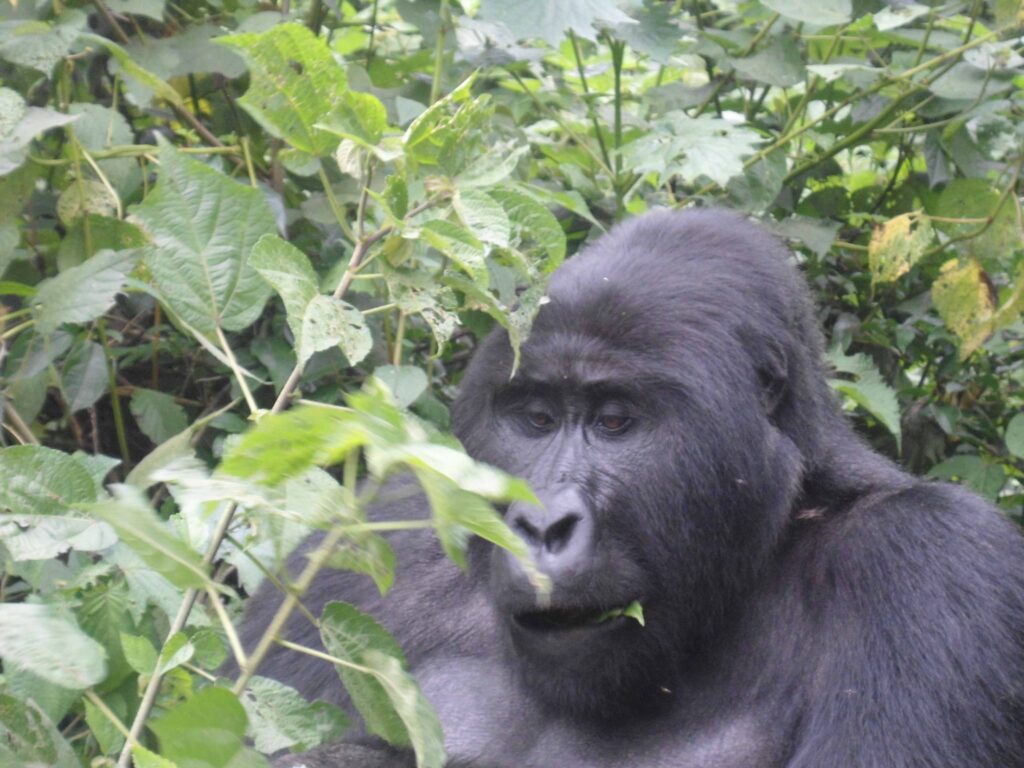
So, gorilla trekking tours are possible in Uganda, Rwanda, and DR Congo, so your first decision is where to visit. I’ve put together this section to help you decide which is the best destination for gorilla trekking, based on various factors.
Choosing a Country for Gorilla Trekking
🇺🇬 Why Uganda?
- Good value: Permits in Uganda are $800, which is $700 cheaper than in Rwanda.
- Other activities: After trekking, you can arrange a safari at the nearby Queen Elizabeth National Park to see lions, elephants, and other wild animals.
- Relative security: Uganda is relatively safe and has a good tourist infrastructure.
🇷🇼Why Rwanda?
- Highly convenient: Volcanoes National Park is a short drive from Kigali, making it extremely convenient to trek gorillas if you have limited time.
- Extremely safe: Of the three countries for gorilla trekking, Rwanda is the safest, with extra measures taken to protect tourists.
🇨🇩Why DR Congo?
- Cheap permits: The only reason to choose DR Congo over Rwanda and Uganda is the cost of the permits, which currently go for $400 ($200 in the off-season).
Best Time to Visit
After choosing the country to visit for gorilla trekking, you must decide when to travel. In East Africa, there are two primary seasons: wet and dry. Don’t worry about spring, summer, fall, and winter. Temperatures remain similar throughout the year; the only difference is whether you’re going to get wet.
I strongly advise you to go gorilla trekking during the dry season. Uganda, Rwanda, and eastern DR Congo have two dry seasons and two wet seasons.
Check out the table below for the details on the main dry and wet seasons in the national parks in Uganda, Rwanda, and DR Congo to help you plan your trip:
| 🇺🇬Uganda (Bwindi & Mgahinga) | 🇷🇼Rwanda (Volcanoes National Park) | 🇨🇩DR Congo (Virunga National Park) | |
| ☀️Dry Seasons | June to August; December to February | June to Mid-September; January to February | June to August; December to February |
| 🌧Wet Seasons | March to May; September to November | March to May; Mid-September to November | March to May; Mid-September to November |
The dry and wet seasons are similar in each park as the forests are close to one another. However, when you spend time in East Africa, you will realise that every park has its own climate, so things are slightly different, depending on where you visit.
From my own experience and after researching online for this article, I recommend the following as the best months for visiting each country for gorilla trekking:
- Uganda = December
- Rwanda = January
- DR Congo = January
How to Choose a Tour Operator
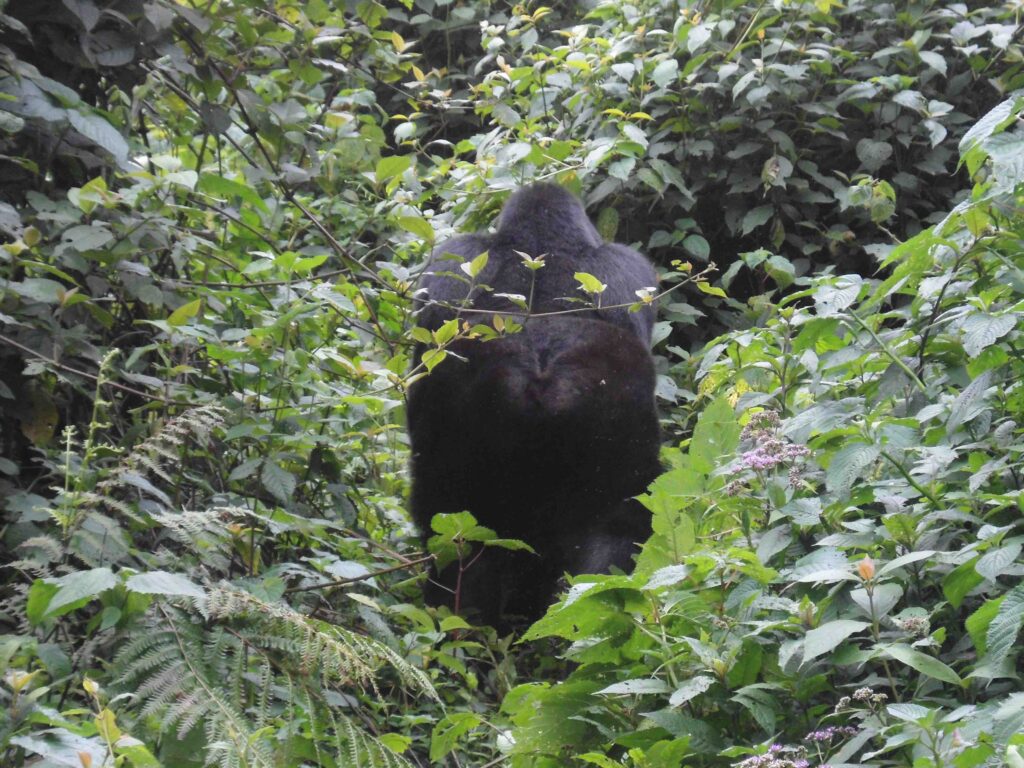
Regardless of the country you trek in, you must arrange gorilla trekking via a tour operator. In Uganda, tour operators are required to book your permit for you, while it’s easier to arrange permits in both Rwanda and DR Congo via an operator or agent.
I used Safari.com for my gorilla experience, and I can’t recommend them enough. They took care of everything, from internal transfers to park accommodation and permits.
Their 4-Day Uganda Fly-In Safari is a brilliant option if you want everything taken care of, as it’s inclusive of internal flights, quality accommodation, all meals and transfers.
They also cover Rwanda, with this luxury 5-Day Safari, inclusive of the gorilla trek and an experience with golden monkeys. Again, everything is taken care of, and you have expert travel consultants on hand, ready to personalise all aspects of your trip to Africa.
I had a brilliant experience with Safari.com on my first trip to Uganda, but don’t just take my word for it. The company scores 4.9/5.0 from over 1,000 Trustpilot reviews, illustrating their trustworthiness and attention to detail.
Here are a couple of my favourite recent reviews of the experience of booking with Safari.com:
“Had a great experience booking our trip to Africa. Sara Van Coillie was super helpful, and she made planning our trip a breeze! Super nice, respectful, and attentive. Highly recommend.” Ryan Khoury, CA.
“Shann was extremely helpful in advising us and getting a great price for the safari extension of our trip. She beat the price of the all-inclusive trip and was able to extend our stay.” Jacqueline Stewart, US.
Costs & Permits
At this stage, you need to think about how much a gorilla trek will cost you. Unfortunately, this isn’t really an activity you can do on the cheap, given that it costs between $400 and $1,500 for the permit alone.
Having visited each of the three countries, I can tell you that, anecdotally, Uganda is the cheapest of the three for things like fuel, hotels, and eating out, but it’s still not as cheap as you might expect, coming from the USA or Europe.
If you want to start with a ballpark figure, you can expect gorilla trekking for mid-range to high-end trips to cost around $1,000 to $1,500 per night, based on two or four people sharing the cost of in-country transport and accommodation.
Expert Insight on Costs: The View of a Tour Operator
I’m grateful to Andrew Bitamazire from AJ Tours in Kampala for giving me the benefit of his expert insight while preparing this article.
Based on his 10+ years of experience arranging gorilla trekking in East Africa, I asked him which country represents the best value for money. Here’s what he had to say:
“If money isn’t an issue, go to Rwanda. The hotels are luxurious and all-inclusive, and journey times are much shorter than in Uganda and Congo. Also, the roads are better, and camera-enforced speed limits make them much safer.
If your gorilla trek is part of a bigger African adventure and you want to go on a safari, I recommend Uganda. Before or after your trek, you can go to Queen Elizabeth, which is about an hour away from Bwindi if the road is good.
There’s also cheaper accommodation around the parks in Uganda, which isn’t available in Rwanda. So, if you’re on a tighter budget, Uganda is a better option, though you need a little more time to cover the ground, given that the gorillas live 10+ hours away from Entebbe Airport.
As for Congo, I wouldn’t recommend it, particularly with the ongoing conflict in the East. We used to run successful tours to Nyiragongo and Virunga, but we haven’t gone to Congo for the last few years.
Also, when planning for Congo, there’s a lot of unpredictability. Permit prices can change with little notice, and there are occasional border issues, which can be daunting for tourists. Despite the cheap permit price, it’s not worth it at the moment.”
What to Expect on a Gorilla Trekking Adventure
Okay, now it’s time for my first-hand review of gorilla trekking. What’s it actually like? What do you need to know before arriving at the park?
Trekking Experiences and Challenges
Now that I live close to Bwindi, I’ve had conversations with tourists who have arrived in the car park for the briefing, only to turn around and see the gorillas within seconds of leaving.
Other times, people must walk for hours before encountering the gorillas deeper in the forest. When I did my trek, I walked for around four hours, mostly uphill, so it was tough going.
Ultimately, every gorilla trek is unique, and you don’t know until the morning of your hike where the gorillas will be when you visit them.
As such, it’s best to be prepared for a reasonably long and strenuous walk through dense forest to reach the gorillas in their natural habitat. I cover packing essentials and other things to consider in the following section.
Encounters with Gorillas
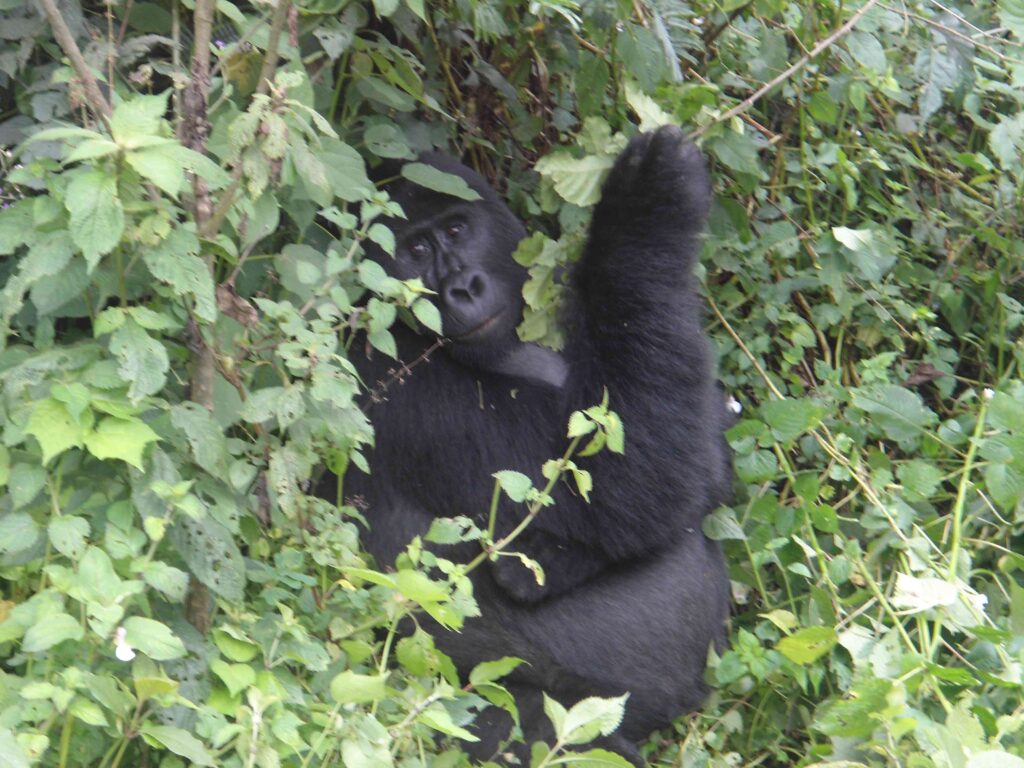
I have been on 10+ safaris in Africa, and I can safely say that my one hour with the gorillas was the most incredible wildlife experience of my life.
Sure, I’m no David Attenborough, but I can’t imagine anything purer than looking into the eyes of one of our closest relatives and observing them at their own pace and in their natural environment.
Something to recognise before going on a trek is that you’re not visiting a zoo or a sanctuary. While these gorillas are habituated, they’re wild and unpredictable.
Don’t overstep the mark, and always listen to your guides. Overfamiliarity is a bad move. Never try to touch or approach a wild gorilla, even if they walk within inches of you (as happened to me!).
You should also avoid staring into a gorilla’s eyes for any length of time, as doing so can be perceived as threatening.
Practically every gorilla trek is uneventful and safe. However, having spoken to tour operators and park rangers, I can say that incidents are nearly always due to visitors not following the rules.
So, for a memorable experience for all the right reasons, be respectful, keep your distance, and listen to the rangers.
Safety Guidelines and Rules
Before entering the park, your guide and the rangers will fully brief you on what to expect, including details of what you can and can’t do during the hike or your time with the gorillas.
Having recently listened to this briefing, here are some of the rules and safety guidelines to be aware of before your trek:
- Age: You must be at least 15 to trek gorillas in Africa.
- Permit: A valid permit is required for all trekkers, dated and approved by the wildlife authority.
- Health: You must not be sick when trekking to the gorillas, as they are susceptible to human illness and infection.
- Food & drink: Food and drink cannot be taken in the vicinity of the gorillas.
- Group size: No more than eight people can trek to a family of gorillas at any given time.
- Distance: You must not get closer than seven metres to the gorillas.
- Time: Unless you’re on a habituation permit, you can only spend one hour with the gorillas before returning to camp.
- Photography: Photos and videos are permitted, but flash photography is prohibited.
- Noise: Keep your voice low, turn your mobile phone to silent, and avoid sudden movements.
- Litter: Do not drop litter, and take everything that you carry with you out of the park.
Preparing for Your Trek
Before wrapping up my ultimate Africa gorilla trekking guide, I want to give you some handy, practical information to help you prepare for your trip.
Packing Essentials
What should you take on a gorilla trek, and what should you wear? Though it might be hot, a long shirt and trousers are non-negotiable. You don’t want to get bitten or scratched as you walk through the bush. A sturdy pair of walking boots is also essential.
You don’t need to rock up to an expensive outdoor shop and buy all the latest gear. Just dress sensibly and make sure you have the right footwear.
Here’s a list of things I took with me – I’ve added “optional” to the items that you can leave behind if you want to travel light:
☑️Sturdy hiking boots
☑️Long sleeves and trousers
☑️A hat (optional)
☑️A light rain jacket
☑️Waterproof trousers (optional)
☑️A camera or smartphone
☑️A walking stick (optional)
☑️Insect repellent and sunscreen
☑️Water & a packed lunch
Fitness Preparation
I’m not the fittest guy in the world, but I can walk pretty well and swim a few times a week to keep myself in shape. I didn’t do any preparation for my gorilla trek, and despite walking for around six hours in total, I didn’t feel overly tired after my day in the forest.
The terrain is uneven, and though there are tracks, much of your walking will be through the bush, with rangers chopping the vegetation in front of you.
So, you don’t need to be a marathon runner to hike to the gorillas, but you should be prepared for several hours in the bush at high altitude.
If you have breathing difficulties or are particularly unfit, speaking to your GP before booking your trek might be a good idea. They can advise whether you’re fit enough to undertake the hike and offer tailored tips on preparing for your trek.
Cultural Sensitivity and Respect
When gorilla trekking in Uganda, it’s essential to be mindful of the cultural sensitivities of the local communities, especially those living near the forests, such as the Batwa and Bakiga people.
Modest clothing is encouraged, as rural areas tend to be conservative, and revealing outfits may be considered disrespectful. Visitors should always ask for permission before taking photographs of local people or their homes, as unsolicited photography can be seen as intrusive.
Respecting local customs and traditions is key, including listening attentively during cultural experiences and avoiding judgmental or dismissive behaviour. Public displays of affection, such as kissing, are generally frowned upon in Ugandan society.
While engaging with local communities, it’s best to support ethical tourism by purchasing locally made crafts through cooperatives and avoiding giving money directly to children. Learning a few basic phrases in the local language can go a long way in building goodwill and showing cultural respect.
The same is true in Rwanda and Congo, in the communities surrounding the national parks.
Reading Recommendations
You don’t need to read up on the life of mountain gorillas before visiting them, but doing so may enhance your experience.
I’ve just finished reading a brilliant book called Walking with Gorillas: The Journey of an African Wildlife Vet, by Dr Gladys Kalema-Zikusoka.
It’s enlightening, informative, and easy to read, providing an excellent context for the environment you’re stepping into.
As a lover of African wildlife, I’ve also read the following books, which you might consider downloading on your Kindle before embarking on your gorilla trekking tour in Uganda or Rwanda:
- Gorillas in the Mist, Dian Fossey
- In the Kingdom of Gorillas: The Quest to Save Rwanda’s Mountain Gorillas, Bill Weber & Amy Vedder
- Gorilla Dreams: The Legacy of Dian Fossey, Georgianne Nienaber
Conclusion
Gorilla trekking is a unique cultural and wildlife experience. But it’s also integral for the future conservation of these magnificent great apes.
As Dr Gladys Kalema-Zikusoka stated in a recent interview: “Gorilla tourism has been a game changer—it gives value to keeping gorillas alive, and it’s helped improve the lives of people living around the parks.”
Though expensive and exclusive, the fee you pay to trek gorillas makes a big difference to the people and the animals within and around the national parks.
It’s a truly once-in-a-lifetime experience, and I’m so glad I emptied my savings to do it.
You now have all the information you need to embark on your gorilla trek in Uganda or Rwanda. I hope you enjoy the experience as much as I did.
Gorilla Trekking Africa FAQs
How close can I get to the gorillas during my tour?
Seven metres. The park rangers will keep you at the appropriate distance during your visit. This is to protect you and the other members of the group, and the gorillas themselves, who are prone to human infections and diseases.
Why is gorilla trekking so expensive?
The cost of gorilla trekking is so high because of the conservation work required to protect the mountain gorillas. In Uganda, 20% of the fee goes directly to the communities, while over 50% goes to conservation efforts in the park.
Is gorilla trekking ethical?
Yes, gorilla trekking is ethical. It’s like going on a safari – you’re travelling to Africa to see these animals in their natural habitat. It’s not like visiting a zoo – mountain gorillas are wild, free, and living their natural life.
Can you see gorillas without trekking?
If you live in and around one of the national parks where the gorillas live, you might see them without entering the park, as they occasionally wander onto community land. However, if you’re visiting for a few days as a tourist, you will need to pay to trek the gorillas.
Is gorilla trekking worth it?
If you’re passionate about conservation and love wildlife, gorilla trekking is the most rewarding wildlife experience on the planet. However, it is expensive, so you will need to save up before heading to Africa.


